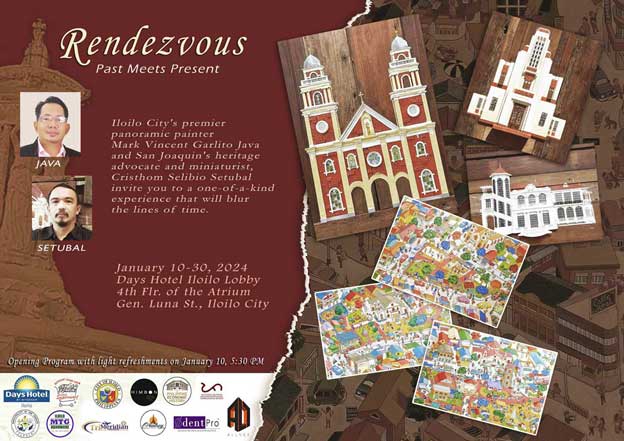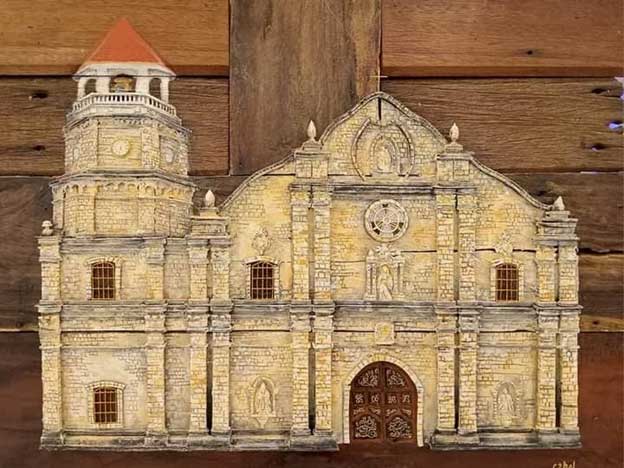
by Noel Galon de Leon, UP Visayas
The profound significance embedded in Rendezvous: Past Meets Present, an art exhibit by Mark Vincent Garlito Java and Cristhom Selibio Setubal, extends far beyond the surface of a planned encounter between two individuals. It transcends the conventional understanding of a scheduled meeting, as Java and Setubal keenly recognize that this convergence signifies the intricate alignment of two distinct timelines, seamlessly weaving them into a singular, harmonious narrative. This nuanced comprehension imparts a heightened depth of meaning to Iloilo, elevating it beyond a mere setting or subject and casting it as a dynamic character in its own right—imbued with narrative complexity and resonating with symbolic depth.
With the inauguration of this art exhibit on January 10, 2024, gracing the lobby of Days Hotel, Java and Setubal ambitiously transcend the conventional confines of art galleries and museums, typically associated with such works. Beyond showcasing their art, these visionary artists recognize the significant role of space, exemplified by the hotel lobby, as an unconventional yet potent platform for presenting local art and culture to visitors and tourists alike. It can be posited that by integrating artistic elements into the hotel lobby, they aim to elevate the overall guest experience, igniting curiosity and inspiring a more profound engagement with the local art and culture. This strategic placement acts as a catalyst, inspiring guests to want to return and discover more about the diverse artistic expressions in the region.
In Java’s artistic repertoire, he skillfully captures the spirit of contemporary sensibility in art creation. Although his maps may seem like ordinary depictions of our urban surroundings at first, a careful examination reveals a deep political subtext intricately woven into each meticulously crafted piece. Beyond the surface appeal of the symbols embedded in Java’s canvases, his artistic sensibility acts as a catalyst for a more profound inquiry, prompting viewers to explore the intentional omissions and engage in existential dialogue. Is it an artistic limitation or a deliberate omission, inviting a thorough exploration of his work beyond its visual aesthetics? Java’s body of work invites nuanced discourse, going beyond the canvas to encourage contemplation on socio-political landscapes and artistic choices alike.
In Setubal’s artistic oeuvre, he transcends the conventional portrayal of churches or building facades. His brushwork skillfully captures the intricate stories woven into their history. Each stroke is not just a visual rendition but a meticulous choreography that beckons viewers beyond the surface. It’s a masterful reminder that art, far from being a mere embellishment in our cultural spaces, acts as a living chronicle, inviting us to engage in a profound dialogue with our shared history. Setubal’s creations serve as a compelling testament to the multifaceted nature of art—an exquisite artifact eloquently resonates with our origins, identity, and cultural heritage, guiding us from aesthetic appreciation to a deeper understanding of our artistic legacy.
By combining the artistic influences of Java and Setubal, they underscore that Iloilo is more than just a place – it’s a character with a profound history. This history is a treasure of local stories that can fuel our creativity. While the act of mapping, like Java’s art, has political undertones, we can’t overlook the importance of the stories it tells, especially in shaping Iloilo’s art scene.
This fusion serves as a roadmap, leading us to revisit the buildings and facades, appreciating their significance. Unfortunately, many Ilonggos tend to overlook these elements today. As we explore this cultural mix, it transforms into a guidepost, encouraging us to rediscover the architectural gems and historical layers that constitute Iloilo’s unique identity.




























Excellent review. Noel sees art in a way that no other Ilonggo art critic can. Articulating his views not only on the aesthetic merits of the artworks but the practical and social relevance of the exhibit in general.